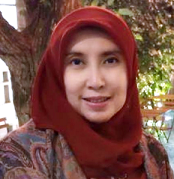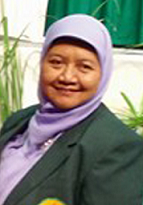HOTS-AEP-COVID-19 and ILMIZI learning model: The 21st-Century environmental learning in senior high school
DOI:
https://doi.org/10.22219/jpbi.v6i2.12161Keywords:
HOTS-AEP-COVID-19, ILMIZI learning model, learning InnovationAbstract
Environmental learning in the Coronavirus Disease 2019 (COVID-19) pandemic requires 21st-Century learning innovation which promotes Higher-Order Thinking Skills (HOTS) of which ILMIZI is the potential learning model. The purpose of this study was to measure the students’ HOTS using HOTS Assessment based on Environmental Problem of COVID-19 (HOTS-AEP-COVID-19) and describe the syntax of ILMIZI model for the implementation of e-learning during the COVID-19 pandemic. The research subjects used were 172 senior high school students randomly selected from Bekasi City in several schools. The descriptive research used online survey as the data collection technique. The results showed that the students HOTS scores measured using HOTS-AEP-COVID-19 were still in very low category either for all students (22.83) or male students (21.32) and female students (23.82). Hence, the ILMIZI model need further evaluation to be implemented as an alternative for the 21st-Century environmental learning.Downloads
References
Ahorsu, D. K., Lin, C. Y., Imani, V., Saffari, M., Griffiths, M. D., & Pakpour, A. H. (2020). The fear of Covid-19 scale: development and initial validation. International Journal of Mental Health and Addiction, 1–9. doi: https://doi.org/10.1007/s11469-020-00270-8
Bakker, A., & Wagner, D. (2020). Pandemic: Lessons for today and tomorrow? Educational Studies in Mathematics, 104, 1-4. doi: https://doi.org/10.1007/s10649-020-09946-3
Barber, W., King, S., & Buchanan, S. (2015). Problem based learning and authentic assessment in digital pedagogy: Embracing the role of collaborative communities. Electronic Journal of E-Learning, 13(2), 59–67. doi: https://doi.org/10.1002/tl.7401
Barricelli, B. R., Gadia, D., Rizzi, A., & Marini, D. L. R. (2016). Semiotics of virtual reality as a communication process. Behaviour and Information Technology, 35(11), 879–896. doi: https://doi.org/10.1080/0144929X.2016.1212092
Bashyam, A. M., & Feldman, S. R. (2020). Should patients stop their biologic treatment during the Covid-19 pandemic. The Journal of Dermatological Treatment, 31(4), 317-318. doi: https://doi.org/10.1080/09546634.2020.1742438
Camacho, D. J., & Legare, J. M. (2015). Opportunities to create active learning techniques in the classroom. Journal of Instructional Research, 4, 38–45. doi: https://doi.org/10.9743/JIR.2015.5
Chin, K. Y., & Chen, Y. L. (2013). A mobile learning support system for ubiquitous learning environments. Procedia - Social and Behavioral Sciences, 73, 14–21. doi: https://doi.org/10.1016/j.sbspro.2013.02.013
Deschryver, M. (2017). Using the web as a higher order thinking partner: Case study of an advanced learner creatively synthesizing knowledge on the web. Journal of Educational Computing Research, 55(2), 240–271. doi: https://doi.org/10.1177/0735633116667356
Erduran, S. (2020). Science education in the era of a pandemic to education for understanding and solving the Covid-19 crisis? Science & Education, 29, 233–235. doi: https://doi.org/10.1007/s11191-020-00122-w
Fischer, E. (2018). Two analogy strategies: The cases of mind metaphors and introspection. Connection Science, 30(2), 211–243. doi: https://doi.org/10.1080/09540091.2017.1350937
Fitzpatrick, B., & Schulz, H. (2015). Do curriculum outcomes and assessment activities in science encourage higher order thinking? Canadian Journal of Science, Mathematics and Technology Education, 15(2), 136–154. doi: https://doi.org/10.1080/14926156.2015.1014074
Georgiev, T. (2020). Coronavirus disease 2019 (Covid-19) and anti-rheumatic drugs. Rheumatology International, 19–20. doi: https://doi.org/10.1007/s00296-020-04570-z
Grant, M., & Smith, M. (2018). Quantifying assessment of undergraduate critical thinking. Journal of College Teaching & Learning, 15(1), 27–38. doi: https://doi.org/10.19030/tlc.v15i1.10199
He, Z. (2020). What further should be done to control Covid-19 outbreaks in addition to cases isolation and contact tracing measures? BMC Medicine, 18(1), 8–10. doi: https://doi.org/10.1186/s12916-020-01551-8
Heong, Y. M., Yunos, J., Othman, W., Hassan, R., Kiong, T. T., & Mohamad, M. M. (2012). The needs analysis of learning higher order thinking skills for generating ideas. Procedia - Social and Behavioral Sciences, 59, 197–203. doi: https://doi.org/10.1016/j.sbspro.2012.09.265
Ichsan, I. Z. (2019). ILMIZI: Innovation learning model for natural science and environmental learning based on HOTS. International Journal for Educational and Vocational Studies, 1(6), 578–584. doi: https://doi.org/10.29103/ijevs.v1i6.1640
Ichsan, I. Z., Rahmayanti, H., Purwanto, A., Sigit, D. V., Singh, C. K. S., & Babu, R. U. M. (2020). HOTS-AEP-Covid-19: Students knowledge and digital worksheet of ilmizi environmental learning model. International Journal of Advanced Science and Technology, 29(6), 5231–5241. Retrieved from http://sersc.org/journals/index.php/IJAST/article/view/19581
Ichsan, I. Z., Sigit, D. V., Miarsyah, M., Ali, A., Arif, W. P., & Prayitno, T. A. (2019). HOTS-AEP: Higher order thinking skills from elementary to master students in environmental learning. European Journal of Educational Research, 8(4), 935–942. doi: https://doi.org/10.12973/eu-jer.8.4.935
Ichsan, I. Z., Sigit, D. V., Rahmayanti, H., Purwanto, A., Rosyid, A., Suwandi, T., Ali, A., & Hermawati, F. M. (2020). Implementasi model pembelajaran ILMIZI dan peningkatan HOTS siswa SD berdasarkan gender pada pembelajaran lingkungan. JIPVA (Jurnal Pendidikan IPA Veteran), 4(1), 11–24. doi: https://doi.org/10.31331/jipva.v4i1.1076
Istiyono, E., Dwandaru, W. S. B., Setiawan, R., & Megawati, I. (2019). Developing of computerized adaptive testing to measure physics higher order thinking skills of senior high school students and its feasibility of use. European Journal of Educational Research, 9(1), 91–101. doi: https://doi.org/10.12973/eu-jer.9.1.91
Lee, A. Y. L. (2016). Media education in the School 2.0 era: Teaching media literacy through laptop computers and iPads. Global Media and China, 1(4) 435–449 doi: https://doi.org/10.1177/2059436416667129
Mbipom, B., Craw, S., & Massie, S. (2018). Improving e-learning recommendation by using background knowledge. Expert Systems, 2018, e12265. doi: https://doi.org/10.1111/exsy.12265
Mhouti, A. El, Erradi, M., & Nasseh, A. (2018). Using cloud computing services in e-learning process: Benefits and challenges. Education and Information Technologies, 23(2), 893–909. doi: https://doi.org/10.1007/s10639-017-9642-x
Mhouti, A. El, Nasseh, A., Erradi, M., & Vasquèz, J. M. (2017). Enhancing collaborative learning in Web 2.0-based e-learning systems: A design framework for building collaborative e-learning contents. Education and Information Technologies, 22(5), 2351–2364. doi: https://doi.org/10.1007/s10639-016-9545-2
Miller, A. L. (2018). The role of creative coursework in skill development for university seniors. Global Education Review, 5(1), 88–107. Retrieved from https://ger.mercy.edu/index.php/ger/article/view/360
Mirabolghasemi, M., Choshaly, S. H., & Iahad, N. A. (2019). Using the HOT-fit model to predict the determinants of E-learning readiness in higher education: a developing Country’s perspective. Education and Information Technologies, 24(6), 3555–3576. doi: https://doi.org/10.1007/s10639-019-09945-9
Ni, L., Zhou, L., Zhou, M., Zhao, J., & Wang, D. W. (2020). Combination of western medicine and Chinese traditional patent medicine in treating a family case of Covid-19 in Wuhan. Frontiers of Medicine. doi: https://doi.org/10.1007/s11684-020-0757-x
Nissim, Y., Weissblueth, E., Scott-Webber, L., & Amar, S. (2016). The effect of a stimulating learning environment on pre-service teachers’ motivation and 21st century skills. Journal of Education and Learning, 5(3), 29. doi: https://doi.org/10.5539/jel.v5n3p29
Nugraini, S. H., Choo, K. A., Hin, H. S., & Hoon, T. S. (2013). Impact of e-AV biology website for learning about renewable energy. TOJET: The Turkish Online Journal of Educational Technology, 12(2), 376–386. Retrieved from http://www.tojet.net/articles/v12i2/12235.pdf
Oncu, E. C. (2016). Improved creative thinkers in a class: A model of activity based tasks for improving university students creative thinking abilities. Educational Research and Reviews, 11(8), 517–522. doi: https://doi.org/10.5897/ERR2015.2262
Parkin, H. J., Hepplestone, S., Holden, G., Irwin, B., & Thorpe, L. (2012). A role for technology in enhancing students’ engagement with feedback. Assessment and Evaluation in Higher Education, 37(8), 963–973. doi: https://doi.org/10.1080/02602938.2011.592934
Quieng, M. C., Lim, P. P., & Lucas, M. R. D. (2015). 21st century-based soft skills: Spotlight on non-cognitive skills in a cognitive-laden dentistry program. European Journal of Contemporary Education, 11(1), 72–81. doi: https://doi.org/10.13187/ejced.2015.11.72
Radovan, M., & Perdih, M. (2016). Developing guidelines for evaluating the adaptation of accessible web-based learning materials. International Review of Research in Open and Distance Learning, 17(4), 166–181. doi: https://doi.org/10.19173/irrodl.v17i4.2463
Rahman, M. M. (2019). 21st century skill “Problem Solving”: Defining the concept. Asian Journal of Interdisciplinary Research, 2(1), 64–74. doi: https://doi.org/10.34256/ajir1917
Reyna, J., Hanham, J., & Meier, P. C. (2019). A framework for digital media literacies for teaching and learning in higher education. E-Learning and Digital Media, 15(4), 176–190. doi: https://doi.org/10.1177/2042753018784952
Saido, G. M., Siraj, S., Nordin, A. B. Bin, & Amedy, O. S. A. (2015). Higher order thinking skills among secondary school students in science learning. The Malaysian Online Journal of Educational Science, 3(3), 13–20. Retrieved from https://mojes.um.edu.my/article/view/12778
Saputri, A. C., Sajidan, S., Rinanto, Y., Afandi, A., & Prasetyanti, N. M. (2018). Improving students’ critical thinking skills in cell-metabolism learning using stimulating higher order thinking skills model. International Journal of Instruction, 12(1), 327–342. doi: https://doi.org/10.29333/iji.2019.12122a
Seechaliao, T. (2017). Instructional strategies to support creativity and innovation in education. Journal of Education and Learning, 6(4), 201–208. doi: https://doi.org/10.5539/jel.v6n4p201
Şener, N., Türk, C., & Taş, E. (2015). Improving science attitude and creative thinking through science education project: A design, implementation and assessment. Journal of Education and Training Studies, 3(4), 57–67. doi: https://doi.org/10.11114/jets.v3i4.771
Sintema, E. J. (2020). Effect of COVID-19 on the performance of grade 12 students: Implications for stem education. Eurasia Journal of Mathematics, Science and Technology Education, 16(7), 1–6. doi: https://doi.org/10.29333/ejmste/7893
Tian, S., Hu, N., Lou, J., Chen, K., Kang, X., Xiang, Z., Chen, H., Wang, D., Liu, N., Liu, D., Chen, G., Zhang, Y., Li, D., Li, J., Lian, H., Niu, S., Zhang, L., & Zhang, J. (2020). Characteristics of Covid-19 infection in Beijing. Journal of Infection, 80(4), 401–406. doi: https://doi.org/10.1016/j.jinf.2020.02.018
Turnip, B., Wahyuni, I., & Tanjung, Y. I. (2016). The effect of inquiry training learning model based on just in time teaching for problem solving skill. Journal of Education and Practice, 7(15), 177–181. Retrieved from https://eric.ed.gov/?id=EJ1103095
Vijayaratnam, P. (2012). Developing higher order thinking skills and team commitment via group problem solving: a bridge to the real world. Procedia - Social and Behavioral Sciences, 66, 53–63. doi: https://doi.org/10.1016/j.sbspro.2012.11.247
Wang, S., & Wang, H. (2011). Teaching higher order thinking in the introductory mis course: A model-directed approach. Journal of Education for Business, 86(4), 208–213. doi: https://doi.org/10.1080/08832323.2010.505254
Winarno, S., Muthu, K. S., & Ling, L. S. (2017). Direct problem-based learning (DPBL): A framework for integrating direct instruction and problem-based learning approach. International Education Studies, 11(1), 119–126. doi: https://doi.org/10.5539/ies.v11n1p119
Yeung, S. yin S. (2015). Conception of teaching higher order thinking: Perspectives of Chinese teachers in Hong Kong. Curriculum Journal, 26(4), 553–578. doi: https://doi.org/10.1080/09585176.2015.1053818
Zhou, G., Chen, S., & Chen, Z. (2020). Back to the spring of Wuhan: Facts and hope of Covid-19 outbreak. Frontiers of Medicine, 1–4. doi: https://doi.org/10.1007/s11684-020-0758-9
Zohar, A., & Agmon, V. A. (2018). Raising test scores vs. teaching higher order thinking (HOT): Senior science teachers’ views on how several concurrent policies affect classroom practices. Research in Science and Technological Education, 36(2), 243–260. doi: https://doi.org/10.1080/02635143.2017.1395332
Downloads
Published
Issue
Section
License
Authors who publish with JPBI (Jurnal Pendidikan Biologi Indonesia) agree to the following terms:
- For all articles published in JPBI, copyright is retained by the authors. Authors give permission to the publisher to announce the work with conditions. When the manuscript is accepted for publication, the authors agree to automatic transfer of the publishing right to the publisher.
- Authors retain copyright and grant the journal right of first publication with the work simultaneously licensed under a Creative Commons Attribution-ShareAlike 4.0 International License that allows others to share the work with an acknowledgment of the work's authorship and initial publication in this journal.
- Authors are able to enter into separate, additional contractual arrangements for the non-exclusive distribution of the journal's published version of the work (e.g., post it to an institutional repository or publish it in a book), with an acknowledgment of its initial publication in this journal.
- Authors are permitted and encouraged to post their work online (e.g., in institutional repositories or on their website) prior to and during the submission process, as it can lead to productive exchanges, as well as earlier and greater citation of published work (See The Effect of Open Access).

This work is licensed under a Creative Commons Attribution-ShareAlike 4.0 International License.
























